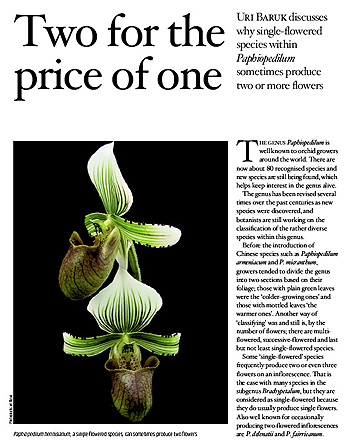|
|
|
|
| Mr. Uri Baruk |
| URIBARUK graduated as a biochemist and is an
orchid grower specialising in Paphiopedilum and its allies. E mail : "Baruk" <baruk1@club-internet.fr> |
| Two for the price of one | |
| URI BARUK discusses why single-flowered species within Paphiopedilum sometimes produce two or more flowers | |
| The genus Paphiopedilum is well known to orchid
growers around the world. There are now about 80 recognised species
and new species are still being found, which helps keep interest
in the genus alive. The genus has been revised several times over the past centuries as new species were discovered, and botanists are still working on the classification of the rather diverse species within this genus. Before the introduction of Chinese species such as Paphiopedilum armeniacum and P. micranthum, growers tended to divide the genus into two sections based on their foliage; those with plain green leaves were the ecolderÐgrowing onesf and those with mottled leaves ethe warmer onesÕ. Another way ofeclassifyingf was and still is, by the number of flowers; there are multiflowered, successive-flowered and last but not least single-flowered species. Some esingle-floweredf species frequently produce two or even three flowers on an inflorescence. That is the case with many species in the subgenus Brachypetalum, but they are considered as single-flowered because they do usually produce single flowers. Also well known for occasionally producing two-flowered inflorescences are P. delenatii and P. fairrieanum. |
|
 Paphiopedilum hennisianum, a single-flowered species, can sometimes produce two flowers. |
|
| Dormant buds The inflorescence on single-flowered species generally carries two buds. One of these develops into a flower while the second, dormant bud is located in the apical bract and most often does not develop. When it does, it produces a second flower and another dormant bud. The dormant bud is quite variable in size and shape and in some species it is almost non-existent, but its size does not seem to be evidence of the capability of producing a second flower. In Paphiopedilum superbiens var. curtisii, for example, the dormant bud is so small that it is necessary to remove the bract to see it, while, on the contrary, the dormant bud on P. fowliei, which is several millimeters long, exceeds the bract in length, yet both these species are capable of producing a second flower. |
|
|
Paphiopedilum malipoense var . jackiiseldom produces two-flowered inflorescences |
Triggering the phenomenon It has been suggested that egood culturef could trigger the development of the second bud and, while this might be true to certain extent, it does not fully explain the phenomenon. In some cases egenetic controlf (or lack of control) might be a more appropriate explanation. |
| While many single-flowered species with known capacity to produce two or even more flowers seem to dispose them appropriately, others seem to have trouble in organising a proper display, simply because the second flower was not supposed to develop, resulting in overlapping petals and in some cases squeezed flowers. So besides those mentioned above, which species occasionally produce two-flowered inflorescences? Having grown this genus for more than 20 years, I have had some two-flowered inflorescences (but not that many) on plants of Paphiopedilum urbanianum, P. tonsum, P. hennisianum and, surprisingly, P. malipoense var. jackii. While this might not be big news for Paphiopedilum enthusiasts, I am certain that growers in general will take a closer look the next time one of their single-flowered Paphiopedilum species is preparing an inflorescence; you never know, perhaps you will get a second flower! | |
|
|
|